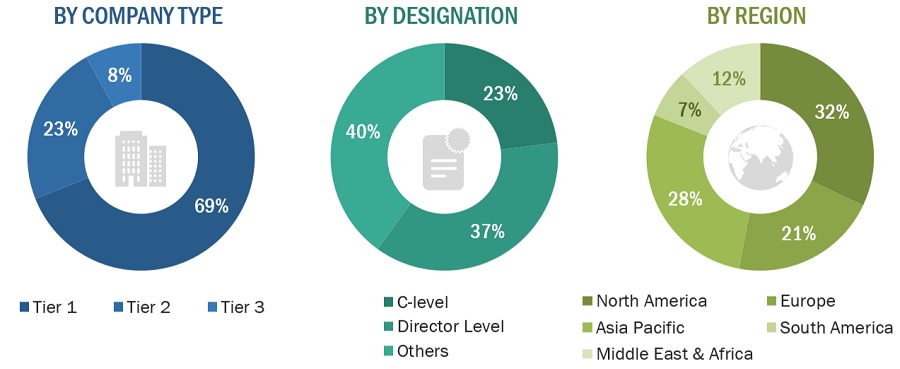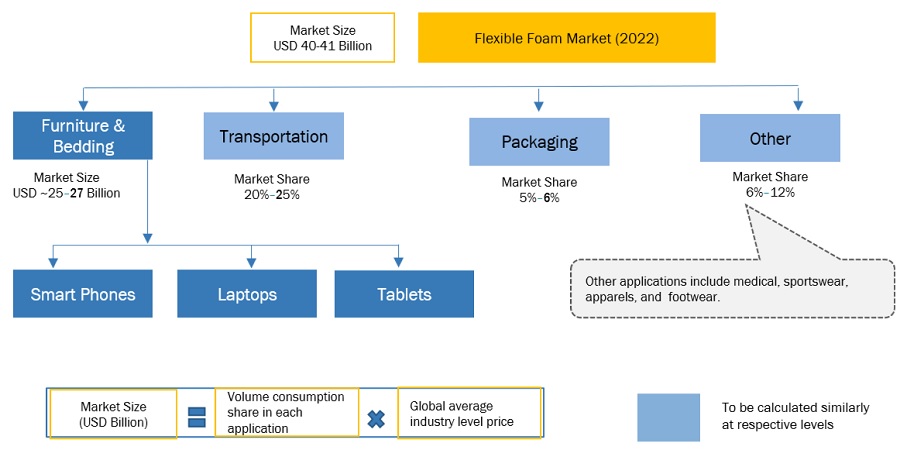The study involved four major activities in estimating the market size for flexible foam. Exhaustive secondary research was done to collect information on the market, the peer market, and the parent market. The next step was to validate these findings, assumptions, and sizing with industry experts across the value chain through primary research. Both top-down and bottom-up approaches were employed to estimate the complete market size. Post that, the market breakdown and data triangulation procedures were used to estimate the market size of the segments and subsegments.
Secondary Research
Secondary sources used in this study included annual reports, press releases, and investor presentations of companies; white papers; certified publications; articles from recognized authors; and gold standard & silver standard websites such as Factiva, ICIS, Bloomberg, and others. The findings of this study were verified through primary research by conducting extensive interviews with key officials such as CEOs, VPs, directors, and other executives. The breakdown of profiles of the primary interviewees is illustrated in the figure below:
Primary Research
The Flexible foam market comprises several stakeholders, such as raw material suppliers, end-product manufacturers, and regulatory organizations in the supply chain. The demand side of this market is characterized by the automotive, medical, electronics, and others. The supply side is characterized by advancements in technology and diverse application industries. Various primary sources from both the supply and demand sides of the market were interviewed to obtain qualitative and quantitative information.
Breakdown of Primary Participants

Note: Tier 1, Tier 2, and Tier 3 companies are classified based on their market revenue in 2022, available in the public domain, product portfolios, and geographical presence.
Other designations include consultants and sales, marketing, and procurement managers.
To know about the assumptions considered for the study, download the pdf brochure
|
COMPANY NAME
|
DESIGNATION
|
|
Dow Inc.
|
Director of Marketing
|
|
BASF SE
|
Manager- Sales & Marketing
|
|
Huntsman Corporation
|
Sales Manager
|
|
Covestro AG
|
Production Manager
|
Market Size Estimation
Both top-down and bottom-up approaches were used to estimate and validate the total size of the Flexible foam market. These methods were also used extensively to estimate the size of various subsegments in the market. The research methodology used to estimate the market size includes the following:
-
The key players in the industry have been identified through extensive secondary research.
-
The supply chain of the industry has been determined through primary and secondary research.
-
All percentage shares, splits, and breakdowns have been determined using secondary sources and verified through primary sources.
-
All possible parameters that affect the markets covered in this research study have been accounted for, viewed in extensive detail, verified through primary research, and analyzed to obtain the final quantitative and qualitative data.
Flexible foam Market: Bottom-Up Approach

To know about the assumptions considered for the study, Request for Free Sample Report
Flexible foam Market: Top-Down Approach

Data Triangulation
After arriving at the overall market size—using the market size estimation processes as explained above—the market was split into several segments and subsegments. To complete the overall market engineering process and arrive at the exact statistics of each market segment and subsegment, data triangulation and market breakdown procedures were employed, wherever applicable. The data was triangulated by studying various factors and trends from both the demand and supply sides in the flexible foam industry.
Market Definition
Flexible foams are a type of foam material that can be bent or compressed without breaking. According to the “British Plastics Federation”, flexible foam is the foam used in a variety of applications such as upholstered furniture, mattresses, automotive and packaging. Flexible foam can be classified into two types: slabstock foam and molded foam. Slabstock foam is produced in continuous sheets and is used in applications such as furniture, bedding, and automotive interiors. Molded foam, on the other hand, is produced in a mold and is used in applications such as automotive seating, headrests, and armrests.
Key Stakeholders
-
Flexible foam manufacturers
-
Flexible foam distributors
-
Raw material suppliers
-
Government and research organizations
-
Investment banks and private equity firms
-
Research & development institutions
-
Environment support agencies
-
Investment banks and private equity firms
Report Objectives
-
To define, describe, and forecast the global flexible foam market size in terms of volume and value
-
To provide detailed information about the significant drivers, restraints, challenges, and opportunities influencing market growth
-
To estimate and forecast the market size based on type, and application
-
To forecast the size of the market based on five major regions–Asia Pacific, North America, Europe, the Middle East & Africa, and South America, along with their key countries
-
To strategically analyze the micromarkets1 with respect to individual growth trends, prospects, and their contribution to the overall market
-
To analyze opportunities in the market for stakeholders and to provide a competitive landscape of market leaders
-
To analyze recent developments such as agreements, mergers & acquisitions, expansions, and product launches in the market
-
To strategically profile key market players and comprehensively analyze their core competencies2 and market share
Available Customizations
Along with the given market data, MarketsandMarkets offers customizations according to the company’s specific needs. The following customization options are available for the report:
Regional Analysis
-
Further breakdown of a region with respect to a particular country or additional application typse
Company Information
-
Detailed analysis and profiles of additional market players (up to five)



Growth opportunities and latent adjacency in Flexible Foam Market